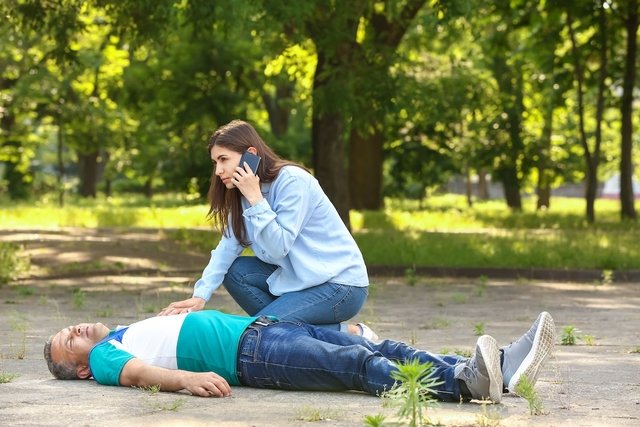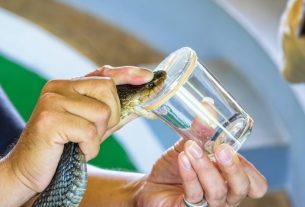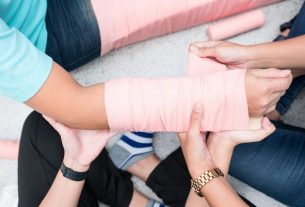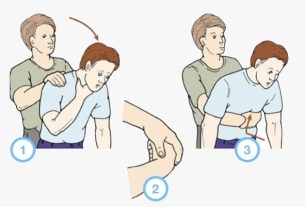Anaphylactic shock is a serious allergic reaction that can lead to the throat closing, preventing adequate breathing and potentially leading to death within minutes. Therefore, anaphylactic shock must be treated as quickly as possible.
First aid in this case is important to ensure the person’s chances of survival and includes:
- Call 911 immediately or take the person immediately to the emergency room;
- Apply the adrenaline injection or penon the lateral portion in the middle of the thigh, which is usually carried by people who have known allergies, to use in emergencies;
- Lay the person on their back and raise your feet above heart heightto facilitate blood circulation;
- Lay the person on their side if the person is vomiting or have any bleeding from the mouth;
- Loosen your clothes and cover the person with a coat or blanket, unless you suspect an injury to the head, neck, back or legs;
- Do not give oral medications or any liquid for the person to drink if the person is having difficulty breathing;
- Check if the person is breathing;
- Give cardiac massage if the person is not breathing, until the ambulance arrives. See here how to do it correctly;
- Call family or emergency contacts that the person has on a piece of paper, bracelet, card or cell phone.
If anaphylactic shock occurred after an insect or snake bite, you should wash the area with soap and water and apply ice to the area to reduce the spread of the venom.

How to recognize anaphylactic shock
The first symptoms of anaphylactic shock are:
- Increased heart rate;
- Difficulty breathing;
- Shortness of breathe;
- Cough and wheezing;
- Stomach ache;
- Nausea and vomiting;
- Swelling in the lips, tongue or throat;
- Difficulty swallowing or speaking;
- Pale skin and cold sweat;
- Intense itching of the body and redness of the skin;
- Dizziness and fainting;
- Mental confusion;
- Cardiac arrest.
These symptoms can appear seconds or hours after contact with the substance that causes the allergic reaction, which is usually a medicine, the venom of animals such as bees and wasps, foods such as shrimp and peanuts, and gloves, condoms or other objects made of latex. .
What to do to avoid anaphylactic shock
The best way to prevent anaphylactic shock is not to have contact with the substance that causes the allergy, avoiding consuming shrimp and seafood or contact with objects made of latex, for example.
Another prevention measure is to ask your doctor to prescribe a shock treatment kit, and learn how to inject yourself with adrenaline, if necessary. Learn how to give the adrenaline injection correctly.
In addition, you should inform friends and family about your allergy and teach them how to use the emergency kit. It is also important to wear a bracelet in public and crowded places that informs you about your allergy, to facilitate first aid.
How is treatment carried out in the hospital
In the hospital, the person in anaphylactic shock will quickly be treated with an oxygen mask to facilitate breathing and an injection of adrenaline into the muscle, which will act on the body, reducing the allergic reaction and normalizing the person’s vital functions. See more details on the treatment of anaphylactic shock.
Bibliography
- BRITISH RED CROSS. Learn first aid for someone having a severe allergic reaction (anaphylaxis). Disponível em: <https://www.redcross.org.uk/first-aid/learn-first-aid/allergic-reaction>. Acesso em 07 mar 2023
- AUSTRALASIAN SOCIETY OF CLINICAL IMMUNOLOGY AND ALLERGY. ASCIA First Aid Plan for Anaphylaxis. Disponível em: <https://www.allergy.org.au/hp/anaphylaxis/first-aid-for-anaphylaxis>. Acesso em 07 mar 2023
- BETTER HEALTH CHANNEL AUSTRALIA. Allergic reactions emergency first aid. Disponível em: <https://www.betterhealth.vic.gov.au/health/conditionsandtreatments/allergic-reactions-emergency-first-aid>. Acesso em 07 mar 2023
- MCLENDON, K.; STERNARD, B. T. IN: STATPEARLS (INTERNET). TREASURE ISLAND (FL): STATPEARLS PUBLISHING. Anaphylaxis. 2022. Available at: <https://www.ncbi.nlm.nih.gov/books/NBK482124/>. Accessed on 15 Dec 2022
- BAERLOCHER, M. O.; et al. Allergic-type reactions to radiographic contrast media. CMJ. 182. 12; 1328, 2010
- Muraro, A.. Anaphylaxis: guidelines from the European Academy of Allergy and Clinical Immunology. European Journal of Allergy and Clinical Immunology. Vol.69. 1026-1045, 2014
- MOTA, Inês et. to the.. Approach and Registration of Anaphylaxis in Portugal. Scientific Journal of the Medical Association. 1-11, 2015
- PORTUGUESE SOCIETY OF ALLERGOLOGY AND CLINICAL IMMUNOLOGY. Anaphylaxis. Accessed on February 13, 2020
- AMERICAN ACADEMY OF ALLERGY, ASTHMA & IMMUNOLOGY. ANAPHYLAXIS. Disponível em: <https://www.aaaai.org/conditions-and-treatments/allergies/anaphylaxis>. Acesso em 12 fev 2020
- FISCHER, David et al. Anaphylaxis. Allergy Asthma Clin Immunol. Vol.14(Supl. 2), n.54. 64-70, 2018
- VIRTUAL HEALTH LIBRARY. Anaphylactic shock. Available at: <https://bvsms.saude.gov.br/dicas-em-saude/150-choque-anafilatico>. Accessed on February 12, 2020
- BORGES, Isabela N.; CARVALHO, Joana S.; SERUFO, José C. General approach to anaphylactic shock. Rev Med Minas Gerais. Vol.22, n.2. 174-180, 2012

Sign up for our newsletter and stay up to date with exclusive news
that can transform your routine!
Warning: Undefined array key "title" in /home/storelat/public_html/wp-content/plugins/link-whisper-premium/templates/frontend/related-posts.php on line 12
Warning: Undefined array key "title_tag" in /home/storelat/public_html/wp-content/plugins/link-whisper-premium/templates/frontend/related-posts.php on line 13



